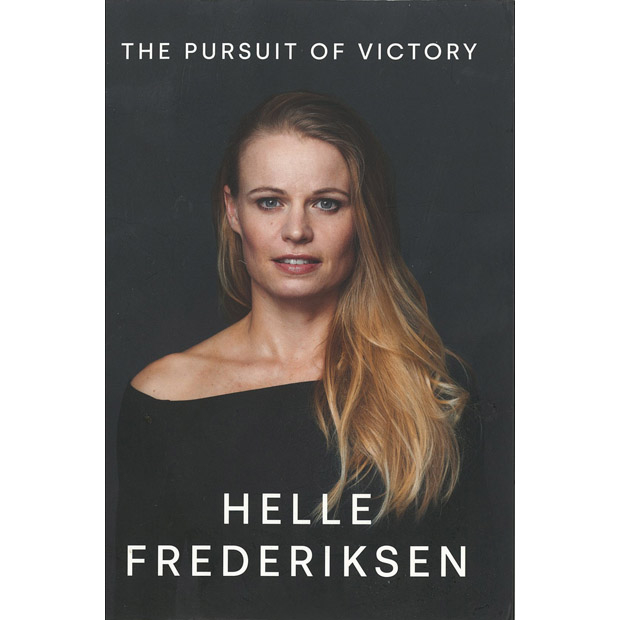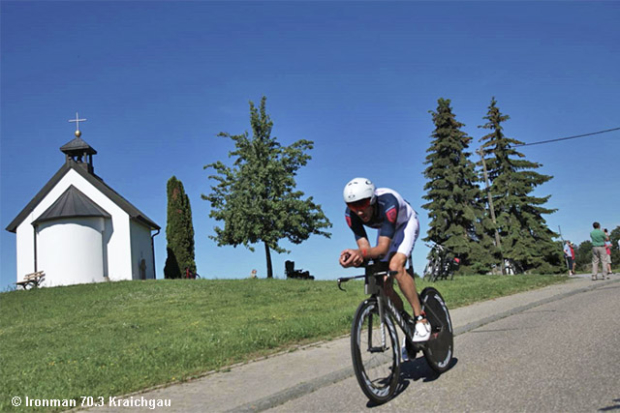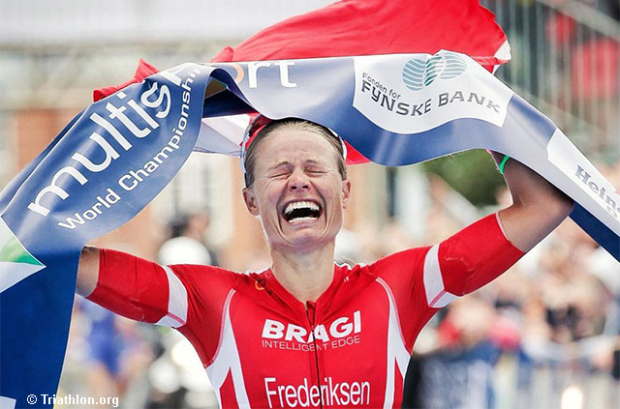Chasing Number One

Throughout her 11-year pro career, Frederiksen won one ITU World Cup, 5 European Cups, 6 Danish national titles and qualified for the 2012 Olympics. After switching from short course to the longer distances in 2013, Frederiksen won 10 Ironman 70.3 titles and one Ironman victory. During her peak year of 2014, Frederiksen took a $100.000 win at the short course Hy-Vee Elite Triathlon Cup and another $100,000 at the half-distance Challenge Bahrain. Most dear to her, she won the 2018 ITU Long Distance World Championship in her home country.
However grand this list of honors, its length Is rivaled only by the number of her broken bones, torn tendons, twisted ligaments, severe road rash, stitches, illnesses, allergies, stress fractures and burned skin running on hot asphalt. You could say her toughest challenges were emotional and mental – often struggling to diagnose and overcome injuries that threatened to end her career.
What makes Frederiksen’s Pursuit of Victory most compelling is her unsparing honesty and a penetrating look inside her heart and soul. It started early with an unapologetic competitive streak in swimming meets at age six. “I loved competing, – but loved winning even more,” she wrote. And always, she was always fighting against the grain of Denmark’s typical cultural modesty, as she was unashamedly ambitious and competitive. Helle wanted no part of the soft way out. She honed her tough streak in the back yard playing goalie to her older brother Per’s hardest shots. “I don’t know how many times the ball thumped me in the face and I ran crying to mom. But it didn’t take long to work out that if I wanted to be part of this, tears weren’t an option.”
After nine years of competitive swimming, Helle hit a plateau, lost her appetite for lane lines and quit the national swim team. In 2004, at age 23, she entered a local sprint triathlon, suited up in a cotton t-shirt and a bike several sizes too big – and she won it. Soon, she was recruited to the Danish national triathlon team, then invited to set her sights on an unsuccessful 2008 Olympic qualification. In May 2007, she lined up at the start of the Lisbon World Cup racing against World Champion Vanessa Fernandes in crowded draft legal event. She was mid pack in a field of 75 when disaster struck. “In a split second, four women and their bikes lay in a heap on the asphalt in front of me,” she wrote. “Out of pure reflex, I hit the brakes hard, somersaulted through the air and landed head first and face down in the pile-up” where a chain ring gouged holes on each side of her carotid artery. The pileup left deep wounds on her face and neck, and also a fear of riding in close quarters in ITU draft legal events.”
Notably, Helle was not overcome with trauma. She was exhilarated to be in the mix, but frustrated at the lost Olympic Qualifying points. Despite full body pain, she finished eighth next week at the San Remo Premium European Cup. Two weeks later she raced the 2007 European Championships in Copenhagen. At the first buoy, Helle was embarrassed to find she was near the end and climbed out. While dropping out was a relief, she immediately regretted it and crawled into the fetal position and remained in shock for 10 minutes.
“I was so embarrassed,” she wrote. “I’d crumpled under pressure and taken the easy way out. It was totally unfair to my coach Michael Krueger, the Danish Triathlon Federation, my parents and all the other people who turned out to cheer me on.”
While she recovered quickly, Frederiksen suffered what became a lifelong spinal disc prolapse of the L5/S1 and chronic injuries to her leg and foot. But her passion for the sport remained undaunted.
Déjà vu
Any thoughts that her bad luck was over, the May 2010 World Championship Series race in Madrid reminded Helle that there would be no immunity from crashes. She had ridden herself into perfect position to contend for her first big WCS result. Once again her Olympic qualifying journey had started with a dreadful crash.
Just before the bike to run transition, the road narrowed at a traffic island and riders to Helle’s left swerved into her lane, pinching her on two sides. The pedal of a rider on her right caught in Helle’s front wheel spokes and launched her. “Just like Lisbon three years earlier,” she wrote, “I hit the asphalt hard, only this time I was dragged 20 meters across the asphalt, slamming me into a tree.” Helle’s description is harrowing: “My blue swimsuit was torn to shreds. I scraped the skin off my back, exposing bone in the sacral area. The bare foot I had taken out of my cycling shoe was skinless and bloody.”
Defiant, she stood up and threw her helmet to the ground and shouted: “Not Again!”
Another challenge
Early in the 2012 Olympic year, Frederiksen developed a severe birch tree allergy which made itself known by a sharp, stabbing sensation in her chest. An MRI showed she had broken a fourth rib where the cartilage met the bone. Weeks later, things improved. But with all the interruptions, she finished a disappointing 27th in London.
Fork in the road
At the start of 2013, Frederiksen faced a choice: Stay with the support of the Danish Federation and stick to a strictly Olympic distance ITU events – or explore the independent, non-drafting Ironman 70.3 world.
In March, the answer came quickly as she won Ironman 70.3 San Juan. As she later recalled, at the finish she screamed at the top of her voice: “A heady mixture of elation and aggression flowed through my veins,” she wrote. “Every hair on my body stood on end. I couldn’t believe this wasn’t a dream.”
The Hunt for Number One
From the start, Frederiksen dreamed of ascending to the number one ranked woman triathlete in the world. Within a fast-growing sport, there are many ways of proving it, many boxes to check off. One of those boxes was make the Olympics, but due to illness and interrupted training, she finished far from the podium. In 2014, there was another way to measure such an honor – and she checked that box by her two $100,000 victories at Hy-Vee and the half Ironman distance Challenge Bahrain which made her the top woman money earner in triathlon. In between those landmark wins, she had another chance – the Ironman 70.3 World Championship in Canada.
The Great Disappointment
At Mt. Tremblant Helle was at the peak fitness of her life. Adding to the luster, the field was stacked with World Champions – Daniela Ryf, Jodie Swallow, Melissa Hauschildt – and stars like Heather Wurtele, Mary Beth Ellis, Annabel Luxford and Heather Jackson.
Starting the bike, Helle was among five women at the front – all careful to adhere to the 12-meter no-draft zone. At the 57 km mark, Frederiksen was following Swallow on a high-speed downhill, but failed to notice her rival slowing abruptly. “Because of a split second of inattention, I entered her draft zone,” [and had no choice but to immediately pass Swallow]. She wrote: “I sat up and immediately slowed down. I had no intention of breaking the rules. The marshals should have realized that.”
Instead, a marshal on a motorbike rode up and stuck a Red Card in her Helle’s face. Four minutes penalty. Disheartened, Helle let the stars go. “I wasn't part of the race anymore,” she recalled. A long-held dream smashed. Devastated, Helle dropped out of the race.
Solving the mystery
To the outsider training and racing might seem the keys to success as an elite triathlete. But for Helle Frederiksen, whose career was marked by the highest highs and lowest lows, perhaps her greatest challenge was a painful problem that baffled a wide range of experts.
Coming off her $200,000 year in 2014 – Helle was hungry to raise her game in 2015. After a third at Challenge Dubai and a win at Galveston 70.3, she was dealing with a chronic pain in her left leg and calf and wanted to fix it. She heard about a California physio who specialized in improving athletes’ flexibility and hip mobility and saw this as a potential “recipe for success.”
Frederiksen started daily exercises prescribed by the physio and found her hips were becoming more mobile – but she also experienced a twisting sensation in her knee joint. After five days something went really wrong. At the end of a week, she could not run. “It felt like a screw had been drilled into my kneecap and was being twisted around inside. I felt a lot of pain throughout my career, but never this severe.”
Frederiksen consulted doctors, physios, chiropractors and acupuncturists. But nobody knew what to do. Diagnoses varied from obscure maladies like Hoffa’s Syndrome and Baker’s Cyst but her knee continued to swell and throb.
Stymied at home in Colorado, Helle flew to Denmark to live with her parents. After three months and no sign of improvement, she took stock. She was 34, and wondered: “Should I give up?”
A sponsor suggested a cortisol injection to reduce the inflammation, but it only made things worse. She also tried kinesiology tape in various configurations. “Had I reached the end of the road?” she wondered. The previous six months had been frustrating. But she retained faith she could make a comeback if she could solve this mystery.
While staying with her parents she traveled 3.5 hours each way to be treated by her trusty Italian osteopath Claudio Colombi. By September Helle sought a massage and a good friend recommended a woman in Copenhagen. Patrizia was Italian born and immediately clicked with Helle. Patrizia had a holistic approach, magic touch in massage and intelligent instincts for physical treatment.
Patrizia immediately understood to treat the inflamed knee with ultimate caution, then got to work loosening the fascia – the body’s elastic connective tissue – and the muscles, tendons and ligaments. Her first observation – Helle’s body was compensating, doing everything to avoid strain on the right knee. “That became a vicious circle,” Patrizia told Helle. “You end up with much less muscle mass on the right knee. To relieve and protect it, the left leg became dominant and the right was getting weaker and weaker.”
Helle was afraid of incurring that stabbing pain, so Patrizia gradually increased pressure on the right knee. Then she employed a special tool – a mini trampoline. First step – stand with both feet with equal pressure – immobile – on the trampoline. Then make a slight jump, the soft springy trampoline providing a cushion. Within three weeks Helle’s right leg was stronger. Soon she could activate long dormant muscles. Patrizia‘s program expanded to include water running and short bike rides. In November she had Helle using an anti-gravity treadmill to reduce body weight impact. To avoid a relapse, Helle made sure never to run and cycle on the same day.
By January 2016, Frederiksen was fit enough to attend a training camp in Lanzarote with team Uplace BMC. By mid-January Helle could swim, bike and run on the same day. By February she was training 26 hours a week. Meanwhile Helle remained aware that her cardio vascular fitness outpaced her muscles and tendons, and reminded herself that her legs had not yet done enough weight bearing exercise.
With Patrizia’s help, the calf healed relatively quickly. But the injury had a related effect on Helle’s big toe, which was aggravated by all the running and riding, So, she bought a soft orthotic. Overall, it had been 15 months since the accident. By mid-August 2015, Helle entered her first race back and won Challenge Samorin. It was a personal confidence building victory, but she remained wary as she incurred a minor stress reaction of the bone.
First Ironman
In November of 2017, Helle entered her first full Ironman at Arizona and, after a mid-race duel for the lead with Kaisa Sali of Finland, Frederiksen settled for a second place finish in 8:53:35 – a new Danish women’s record. No big celebration, but it bode well for an assault on the ITU Long Distance World Championship on her home course in Denmark the next year.
Finally
As she approached the finish line at the 2018 ITU long distance World Championship, Helle was overwhelmed with pent-up feelings. “A mixture of relief, joy and pride swept over me,” she wrote. “I could hardly contain myself. Winning the World Championship in Odense was a tremendous release and brought a great sense of peace.”
There it was, an official world title, that long held dream. “Even renowned author Hans Christian Andersen,” Helle wrote, “would have had trouble coming up with a better fairy tale.”
For her farewell to triathlon, Helle envisioned was a fast finish at the 2019 Ironman Copenhagen. But after a painful pre-race workout, she saw a doctor who said her foot had an early stage stress fracture which would take 12 weeks to heal. After a heart-to-heart talk with husband Ben Powell he asked her: “What difference would it make to your career?” “None. No difference.” “Yeah. That’s a decision then.”
Instead, race officials offered to let Helle take a ceremonial last run down the finish chute to the cheers of her countrymen.
Frederiksen summed it up nicely: “My quest for victory and to explore the physiological limits of my body had taken me to the top of the mountain. It was time to sit down and enjoy the view.”
In this detailed journal of her racing years, Helle paid tribute to the people who loved her and offered crucial support. Throughout her life, her Mom and Dad were foremost. Coaches started with Thora at her swim club, then Henrik her junior mentor. Her first Danish national triathlon team coach, Michael Krueger, brought her much further. Then Joel Fillol brought Helle to a world class level.
Two Italians were invaluable friends and body mechanics – osteopath Claudio Colombi and physical therapist Patrizia. Frederiksen and Powell soon discovered that it was money well spent to fly them to key races and crucial training emergencies.
Light of her Life
In 2011 at Lanzarote, Helle met Ben Powell of Wales. At first Helle and Powell trained on the hills of Lanzarote. Then their bond strengthened as Ben helped plan her workouts, her schedule, her travels, and became her manager who plotted her commercial identity and sought out sponsors. While Fillol served as head coach, Ben Powell provided eyes on analysis of bike positioning, run form and monitored health. Ultimately, Powell served as her final coach. “Ben is great at reading me and knowing how to handle me,” Helle wrote. By 2013, they knew they were a rare match and married.




